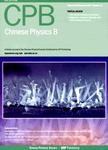The stereodynamic properties of the F+HO(v,j) → HF+O reaction on^1 A' and ~3A' potential energy surfaces by quasi-classical trajectory calculations:Initial excitation effect(v=1-3, j=0 and v= 0, j=1-3)
The stereodynamic properties of the F+HO(v,j) → HF+O reaction on^1 A' and ~3A' potential energy surfaces by quasi-classical trajectory calculations:Initial excitation effect(v=1-3,j=0 and v= 0,j=1-3)作者机构:School of Chemical EngineeringDalian University of Technology State Key Laboratory of Molecular Reaction DynamicsDalian Institute of Chemical PhysicsChinese Academy of Sciences Institute for Computational Sciences and EngineeringLaboratory of New Fiber Materials and Modern Textilethe Growing Base for State Key LaboratoryQingdao University
出 版 物:《Chinese Physics B》 (中国物理B(英文版))
年 卷 期:2013年第22卷第6期
页 面:330-337页
核心收录:
学科分类:08[工学] 0805[工学-材料科学与工程(可授工学、理学学位)] 0827[工学-核科学与技术] 082701[工学-核能科学与工程] 0704[理学-天文学]
基 金:supported by the National Natural Science Foundation of China (Grant Nos. 10874096 and 20633070) the Natural Science Foundation of Qingdao University,China (Grant No. 063-06300510)
主 题:stereodynamics quasi-classical trajectory rotational excitation vibrational excitation
摘 要:The stereodynamic properties of the F + HO (v, j) reaction are explored by quasi-classical trajectory (QCT) calculations performed on the 1At and 3At potential energy surfaces (PESs). Based on the polarization-dependent differential cross sections (PDDCSs) and the angular distributions of the product angular momentum with the reactant at different values of initial v or j, the results show that the product scattering and product polarization have strong links with initial vibrationalrotational numbers of v and j. The significant manifestation of the normal DCSs is that the forward scattering gradually becomes predominant with the initial vibrational excitation increasing, and the scattering angle of the HF product taking place on the 3At potential energy surface is found to be more sensitive to the initial value of v. The product orientation and alignment are strongly dependent on the initial rovibrational excitation effect. With enhancement in the initial rovibrational excitation effect, there is an overall decrease in the product orientation as well as in the product alignment either perpendicular to the reagent relative velocity vector k or along the direction of the y axis, for which the initial rotational excitation effect is much more noticeable than the vibrational excitation effect. Moreover, the initial rovibrational excitation effect on the product polarization is more pronounced for the 3At potential energy surface than for the 1At potential energy surface.



